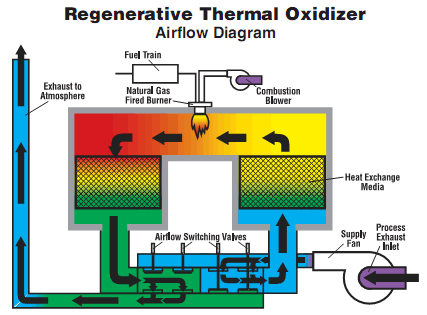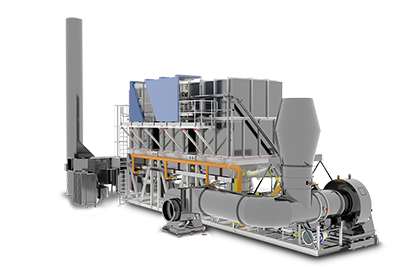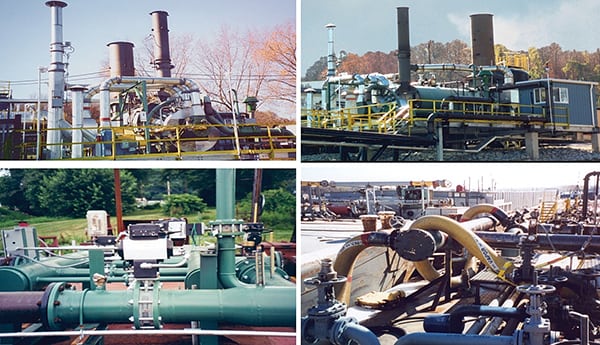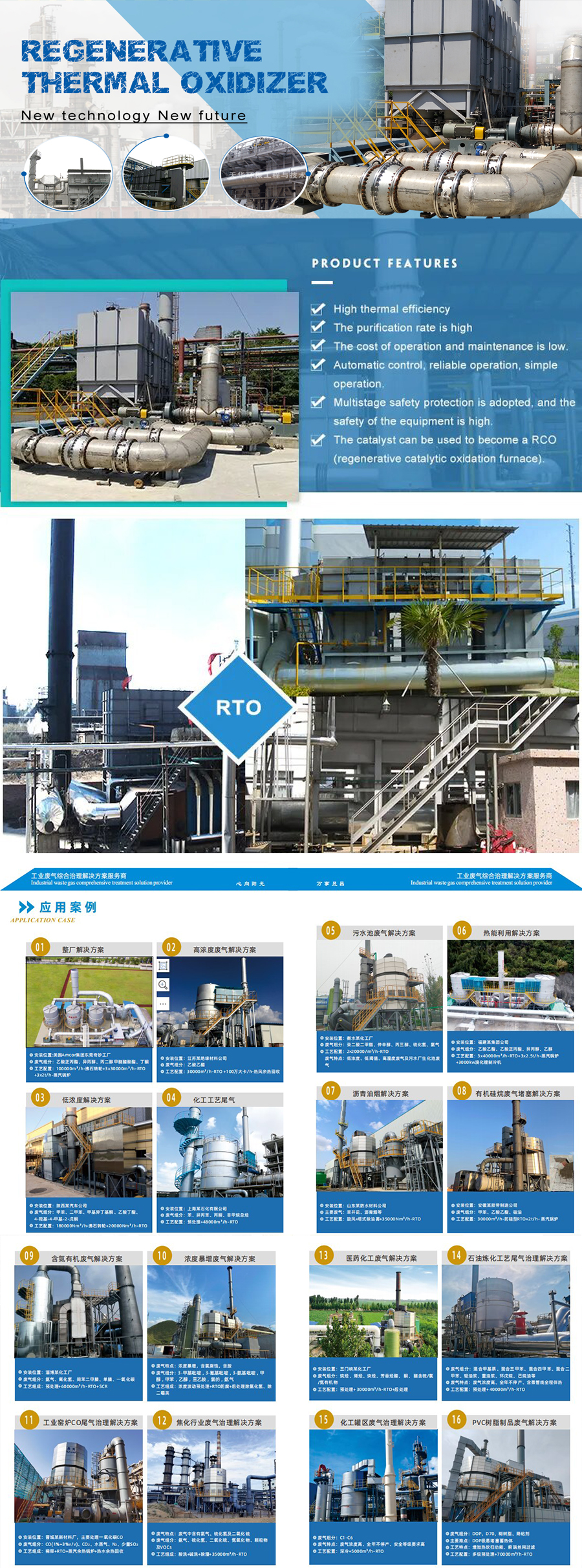Základní informace.
Model NO.
Úžasné RTO
Typ
Spalovna
Low Maintenance
100
Easy Operation
100
Úspora energie
100
Vysoká účinnost
100
Ochranná známka
Bjamazing
Přepravní balíček
Overseas
Specifikace
111
Původ
Čína
Kód HS
2221111
Popis produktu
RTO
Regenerační tepelný oxidátor
Compared with traditional catalytic combustion, direct thermal oxidizer, RTO has the merits of high heating efficiency, low operation cost, and the ability to treat large flux low concentration waste gas. When VOCs concentration is high, secondary heat recycle can be realized, which will greatly reduce the operation cost. Because RTO can preheat the waste gas by levels through ceramic heat accumulator, which could make the waste gas to be completely heated and cracked with no dead corner(treatment efficiency>99%),which reduce the NOX in the Exhausting gas, if the VOC density >1500mg/Nm3, when the waste gas reach cracking area, it has been heated up to cracking temperature by heat accumulator, the burner will be closed under this condition.
RTO can be devided into chamber type and rotary type according to difference operation mode. Rotary type RTO has advantages in system pressure, temperature stability, investment amount, etc
| RTO types | Efficiency | Pressure change (mmAq) | Size | (max)Treatment volume | |
| Treatment efficiency | Heat recycle efficiency | ||||
| Rotary type RTO | 99 % | 97 % | 0-4 | small (1 time) | 50000Nm3/h |
| Three chamber type RTO | 99 % | 97 % | 0-10 | Large (1.5times) | 100000Nm3/h |
| Two chamber type RTO | 95 % | 95 % | 0-20 | middle (1.2times) | 100000Nm3/h |
Regenerative Thermal Oxidizer, Regenerative Thermal Oxidizer, Regenerative Thermal Oxidizer, Thermal Oxidizer, Thermal Oxidizer, Thermal Oxidizer, oxidizer, oxidizer, oxidizer, incinerator, incinerator, incinerator, waste gas treatment, waste gas treatment, waste gas treatment, VOC treatment, VOC treatment, VOC treatment, RTO, RTO, RTO, Rotary RTO, Rotary RTO, Rotary RTO, Chamber RTO, Chamber RTO, Chamber RTO
Adresa: 8 patro, E1, budova Pinwei, Dishengxi road, Yizhuang, ZheJiang, Čína
Typ podnikání: Výrobce/Továrna, Obchodní společnost
Rozsah podnikání: Elektrika a elektronika, Průmyslová zařízení a komponenty, Stroje na výrobu a zpracování, Metalurgie, Nerosty a energie
Certifikace systému managementu: ISO 9001, ISO 14001
Hlavní produkty: Rto, barevná lakovací linka, galvanizační linka, vzduchový nůž, náhradní díly pro zpracovatelskou linku, nanášecí stroj, nezávislá zařízení, dřezový válec, projekt renovace, dmychadlo
Představení společnosti: ZheJiang Amazing Science & Technology Co., Ltd je prosperující hi-tech společnost se sídlem v oblasti hospodářského a technologického rozvoje ZheJiang (BDA). V souladu s konceptem realistického, inovativního, zaměřeného a efektivního naše společnost slouží především průmyslu zpracování odpadních plynů (VOC) a metalurgickým zařízením Číny a dokonce i celého světa. Máme pokročilou technologii a bohaté zkušenosti s projektem zpracování odpadních plynů VOCs, jehož reference byla úspěšně aplikována v průmyslu nátěrových hmot, pryže, elektroniky, polygrafie atd. Máme také roky technologické akumulace ve výzkumu a výrobě plochých linka na zpracování oceli a má téměř 100 příkladů použití.
Naše společnost se zaměřuje na výzkum, návrh, výrobu, instalaci a zprovoznění systému čištění organických odpadních plynů VOCs a projekt modernizace a aktualizace pro úsporu energie a ochranu životního prostředí linky na zpracování ploché oceli. Můžeme zákazníkům poskytnout kompletní řešení pro ochranu životního prostředí, úsporu energie, zlepšování kvality produktů a další aspekty.
Zabýváme se také různými náhradními díly a nezávislými zařízeními pro barevnou lakovací linku, galvanizační linku, mořicí linku, jako je válec, spojka, tepelný výměník, rekuperátor, vzduchový nůž, dmychadlo, svářečka, vyrovnávač napětí, skin pass, dilatační spára, smyk, spárovačka , sešívačka, hořák, sálavá trubice, převodový motor, reduktor atd.

Can regenerative thermal oxidizers be used for treating industrial wastewater?
No, regenerative thermal oxidizers (RTOs) are not typically used for treating industrial wastewater. RTOs are specifically designed for air pollution control and the treatment of gaseous pollutants, such as volatile organic compounds (VOCs) and hazardous air pollutants (HAPs).
Here are some key points to consider regarding the use of RTOs for treating industrial wastewater:
- Operating Principle: RTOs rely on the combustion of pollutants in the gas phase. They utilize high temperatures to thermally oxidize gaseous pollutants, converting them into carbon dioxide and water vapor. However, wastewater treatment involves the removal or transformation of contaminants dissolved or suspended in water, which requires different treatment mechanisms.
- Wastewater Treatment Technologies: Wastewater treatment typically involves processes such as physical separation, chemical treatment, biological treatment, and other specialized techniques depending on the nature of the contaminants. Common wastewater treatment technologies include activated sludge systems, sedimentation tanks, chemical precipitation, filtration, and various other methods tailored to specific wastewater characteristics.
- Environmental Regulations: Industrial wastewater treatment is subject to stringent environmental regulations and discharge standards that govern the quality of effluent released into water bodies. Compliance with these regulations requires the implementation of appropriate wastewater treatment technologies specifically designed for the removal or reduction of contaminants in water, rather than air pollution control technologies like RTOs.
- Integration with Wastewater Treatment Systems: While RTOs are not used for wastewater treatment, they may be integrated into overall industrial process systems where wastewater treatment is also required. In such cases, separate wastewater treatment technologies are employed to treat the wastewater, and RTOs are used to address air emissions resulting from the wastewater treatment process or other industrial operations.
In summary, regenerative thermal oxidizers are not suitable for treating industrial wastewater. They are designed for air pollution control and the destruction of gaseous pollutants. For effective wastewater treatment, industries should employ appropriate wastewater treatment technologies specifically designed for the removal or transformation of contaminants in water.

Are regenerative thermal oxidizers suitable for controlling emissions from food processing operations?
Yes, regenerative thermal oxidizers (RTOs) can be suitable for controlling emissions from food processing operations. Food processing operations often generate volatile organic compounds (VOCs) and odorous compounds that need to be controlled to comply with environmental regulations and maintain air quality. Here are some key points regarding the suitability of RTOs for controlling emissions from food processing operations:
- Kontrola emisí: RTOs are designed to achieve high destruction efficiencies for VOCs and odorous compounds. These pollutants are oxidized within the RTO at high temperatures, typically above 95% efficiency, converting them into carbon dioxide (CO2) and water vapor. This ensures effective control and reduction of emissions from food processing operations.
- Kompatibilita procesu: RTOs can be integrated into the exhaust systems of various food processing operations, capturing and treating the emissions before they are released into the atmosphere. The RTO is typically connected to the process equipment or exhaust stack, allowing the VOC-laden air to pass through the oxidizer for treatment.
- Flexibilita: RTOs offer flexibility in handling a wide range of operating conditions and pollutants. Food processing operations can vary in terms of flow rates, temperature, and composition of emissions. RTOs are designed to accommodate these variations and provide effective treatment even under fluctuating conditions.
- Odor Control: In addition to VOCs, food processing operations can also generate odorous compounds, which can cause nuisance and odor-related complaints. RTOs can be equipped with additional odor control technologies such as activated carbon beds or scrubbers to address odor concerns and ensure the removal of unpleasant odors.
- Dodržování předpisů: Food processing operations are subject to regulatory requirements for air quality and emissions control. RTOs are capable of achieving the necessary destruction efficiencies and can help food processors comply with environmental regulations. The use of RTOs demonstrates a commitment to sustainable practices and responsible management of air emissions.
It is important to note that the specific design and configuration of the RTO, as well as the characteristics of the food processing emissions, should be considered when implementing an RTO for a specific application. Consulting with experienced engineers or RTO manufacturers can provide valuable insights into the proper sizing, integration, and performance requirements for controlling emissions from food processing operations.
In summary, RTOs are a suitable and effective technology for controlling emissions from food processing operations, providing high destruction efficiencies, compatibility with various processes, flexibility in handling operating conditions, odor control capabilities, and compliance with environmental regulations.

How do regenerative thermal oxidizers compare to other air pollution control devices?
Regenerative thermal oxidizers (RTOs) are highly regarded air pollution control devices that offer several advantages over other commonly used air pollution control technologies. Here’s a comparison of RTOs with some other air pollution control devices:
| Comparison | Regenerační tepelné oxidátory (RTO) | Electrostatic Precipitators (ESPs) | Scrubbers |
|---|---|---|---|
| Efficiency | RTOs achieve high VOC destruction efficiency, typically exceeding 99%. They are highly effective in destroying volatile organic compounds (VOCs) and hazardous air pollutants (HAPs). | ESPs are effective in collecting particulate matter, such as dust and smoke, but they are less effective in destroying VOCs and HAPs. | Scrubbers are efficient in removing certain pollutants, such as gases and particulate matter, but their performance may vary depending on the specific pollutants being targeted. |
| Applicability | RTOs are suitable for a wide range of industries and applications, including high-volume exhaust gases. They can handle varying concentrations and types of pollutants. | ESPs are commonly used for particulate matter control in applications such as power plants, cement kilns, and steel mills. They are less suitable for VOC and HAP control. | Scrubbers are widely used for removing acid gases, such as sulfur dioxide (SO2) and hydrogen chloride (HCl), as well as certain odorous compounds. They are often employed in industries such as chemical manufacturing and wastewater treatment. |
| Energy Efficiency | RTOs incorporate heat recovery systems that allow for significant energy savings. They can achieve high thermal efficiency by preheating the incoming process air using the heat from the outgoing exhaust stream. | ESPs consume relatively low energy compared to other technologies, but they do not offer heat recovery capabilities. | Scrubbers generally consume more energy compared to RTOs and ESPs due to the energy required for liquid atomization and pumping. However, some scrubber designs may incorporate heat recovery mechanisms. |
| Space Requirements | RTOs typically require more space compared to ESPs and certain scrubber designs due to the need for ceramic media beds and larger combustion chambers. | ESPs have a compact design and require less space compared to RTOs and some scrubber configurations. | Scrubber designs vary in size and complexity. Certain scrubber types, such as packed bed scrubbers, may require a larger footprint compared to RTOs and ESPs. |
| Maintenance | RTOs generally require regular maintenance of components such as valves, dampers, and ceramic media beds. Periodic media replacement may be necessary depending on the operating conditions. | ESPs require periodic cleaning of collection plates and electrodes. Maintenance activities involve the removal of accumulated particulate matter. | Scrubbers require maintenance of liquid circulation systems, pumps, and mist eliminators. Regular monitoring and adjustment of the chemical reagents used in the scrubbing process are also necessary. |
It’s important to note that the selection of an air pollution control device depends on the specific pollutants, process conditions, regulatory requirements, and economic considerations of the industrial application. Each technology has its own advantages and limitations, and it’s essential to evaluate these factors to determine the most appropriate solution for effective air pollution control.

editor by CX 2023-10-14
